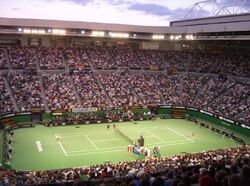Tennis, also known as lawn tennis, is probably the most popular and universal of the racquet-and-ball sports. The basic object of the game is to use a racquet to hit the ball over a net but within the boundaries of the opposite half of the court. It is usually played between two players (called Singles) or teams of two players each (Doubles). Each player uses a racket that is strung to strike a hollow rubber ball covered with felt over a net into the opponent's court. Tennis is an Olympic sport and is played at all levels of society at all ages.
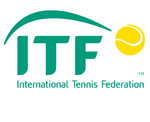
ITF Logo
The game is played competitively or informally by millions of people worldwide. With the proliferation of indoor courts, most notably in the United States, the sport is played all year around. Organized U.S. competition is governed by the United States Tennis Association (USTA) and International matches are regulated by the International Tennis Federation (ITF). Variations include Badminton, Paddle Tennis, Platform Tennis, Racquetball, Squash and Table Tennis.
Tennis is a sport played on a 78 by 36 ft. (23.8 by 11 m) court bisected by a net 3.5ft (1.1m) high. Players hit a ball back and forth across the net with a strung racket. Points are scored when a player fails to return the ball over the net or hits it out of bounds.
Equipment
The equipment used in Tennis is very simple. All that's needed is a tennis racket and a tennis ball.
Racquet
The tennis racquet include a handle, known as the grip, connected to a neck which joins a roughly elliptical frame that holds a matrix of tightly pulled strings. Laminated wood construction yielded more strength in racquets used through most of the 20th century until first metal and then composites of carbon graphite, ceramics, and lighter metals such as titanium were introduced. Technology led to the use of synthetic strings that match the feel of gut yet with added durability.
Under modern rules of tennis, the racquet must adhere to the following guidelines:
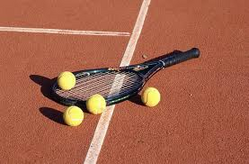
- The hitting area, composed of the strings, must be flat and generally uniform.
- The frame of the hitting area may not be more than 29 inches in length and 12.5 inches in width.
- The entire racquet must be of a fixed shape, size, weight, and weight distribution. There may not be any energy source built into the racquet.
- The racquet must not provide any kind of communication, instruction or advice to the player during the match.
The rules regarding racquets have changed over time, as material and engineering advances have been made. For example, the maximum length of the frame had been 32 inches until 1997, when it was shortened to 29 inches.
Ball
The tennis balls used in this sport is made of rubber covered in yellow felt coating. The felt was originally white, but was changed to yellow so players can easily see it.
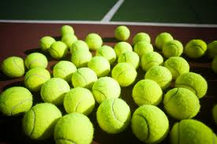
Miscellaneous
Advanced and/or more professional players may make many adjustments to their rackets to improve their performance. An example of this is is to maybe customize the racket with absorbent material so the player can grip better. Players also wear sweat bands on their wrists to keep their hands dry or on their head. Tennis could be played in a variety of shoes, but specialized tennis shoes have wide, flat soles for stability and build-up front structure to avoid excess wear.
Play
Play of a single point
The players or teams start on opposite sides of the net. The player who serves is called the server, while the opposing is called the reciever.
In a legal game, the ball must travel past the net without touching it and into the opposite service box. If the ball hits the net but lands in the service box, this is called a let or net service and the server gets to retake the serve. A fault is a serve that falls long or wide of the service box, or does not clear the net. A foot fault is when a player's foot touches the baseline or an extension of the center mark before the ball is served. If the server commits two faults in a row, it is called a double fault and the receiver will win the point. But, if the serve is alright, then it is considered a legal service.
A legal service starts a rally, which is when the players alternate hitting the ball across the net. A legal return is when the player or team hits the ball before it bounces twice or hits any fixtures except the net on the opponent's side of the court. A player or a team cannot hit the ball twice in a row. The ball that does not make it over the net is called a legal return. The first player or team to fail to make a legal return and breaks te rally loses the point.
Scoring
A tennis match is determined though the best of 3 or 5 sets. A set consists of games and games consist of points.
A game is won by the first player to have won at least four points in total and at least two more points above the opponent. The running score of each game goes like this: scores from zero to three points are called "love" (zero), "fifteen" (1), "thirty" (2), and "forty" (3). If both players score to "forty", it is not called "forty-forty" but is called a "deuce". At deuce, the player or team must score 2 points in a row to win the game. If they score one, it is called "advantage". But, if the opposing player scores a point, then it is back to deuce. This goes on until one player breaks the deuce and scores in a row.
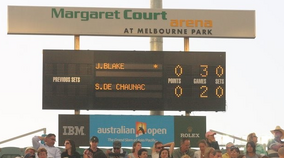
The scoreboard of a match between James Blake and Sébastien de Chaunac at the 2009 Australian Open.
A game point happens in tennis whenever the player in the lead of the game needs only one more point to win that game. This terminology stretches out to sets (set point), matches (match point), and even championships (championship point). Game points, set points, and match points are not part of official scoring and are not announced by the chair umpire in tournament play.
A break point happens if the receiver, not the server, has a chance to win the game in the next point. Break points are important because serving is generally considered to be an advantage, with the server expected to win the games they are serving. A receiver who has one (score of 30-40), two (score of 15–40) or three (score of love-40) consecutive chances to win the game has break point, double break point or triple break point, respectively.
A set is a sequence of games played with service alternating between games. A player wins a set by winning at least six games and at least two games more than the opponent. But, if one player wins six games and the other won five, then an extra game is played to determine the winner. If the leading player wins that game, then that player wins the set 7-5 (7 games to 5 games). If the losing player wins that game, then a tie breaker is played. Only in the final sets of matches at the Australian Open, the French Open, Wimbledon, the Olympic Games, Davis Cup, and Fed Cup are tie-breaks not played. In these cases, sets are played indefinitely until one player has a two-game lead. In tournament play, the chair umpire announces the winner of the set and the overall score.
Tennis court surface
In professional play of tennis, there are five types of surface that could be used. Each surface is different in the speed and height of the bounce of the ball. The same surface plays faster indoors than outdoors.
| Name | Description | Photo |
| Hard | Examples are acrylic (DecoTurf at the US Open, Plexicushion at the Australian Open), asphalt, and concrete. Hard courts provide a faster-paced ball and more bounce. | 
|
| Clay | Examples are green clay (Har-Tru, mainly used in the US) and red clay (French Open). Unlike hard courts, clay courts provide a slower-paced ball and a bounce with fairly more spin. | 
|
| Grass | Grass courts are used at Wimbledon. They provide faster-paced balls and a more erratic bounce. | 
|
| Wood | Although there are no longer any professional tournaments held on wood courts, they were very popular through out the 1800s and the first haf of the 20th century. | 
|
| Carpet | Any removable court covering such as carpet and artificial turf. The bounce can either be higher or lower than on a hard court and there are no longer any professional tournaments held on carpet. | 
|
Shots
In tennis, a tennis player has eight basic shots: serve, forehand, backhand, volley, half-volley, overhead, drop shot, and lob.
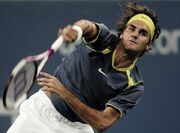
Roger Federer after a serve
Serve
A serve in tennis is the starting shot to a point. The serve is made by tossing the ball in the air then hitting it without touching the net. A winning serve that is not touched by the opponent is called an ace.
Forehand
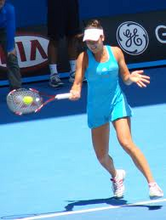
Serbia's Ana Ivanovic doing a one-handed forehand.
For a right-handed player, a forehand is a stroke that starts on the right side of the body and ends on the left side of the body. For a long time, 1920's player Bill Johnston was considered to have had the best forehand of all times. Most forehands are usually executed by one hand holding the racket, but there are some that use two. Currently, France's Fabrice Santoro uses a two-handed forehand. So do females Monica Seles and France's Marion Bartoli.
Backhand
For a right-handed player, a backhand is a stroke that starts on the left side of the body and ends on the right. It can be executed with one hand or two, and has been known to be more difficult to master than the forehand. Players such as Spain's Rafael Nadal and USA's Serena Williams use a two-handed backhand. Don Budge and Ken Rosewall were known tennis players considered to have one of the best backhands of all time.
Other shots
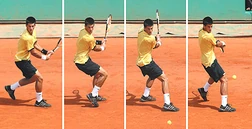
A Backhand by Serbian Novak Djokovic.
A volley is a shot returned to the opponent in mid-air before the ball bounces and is generally executed near the net. A half-volley is a shot made by hitting the ball on the rise just after it has bounced. A swinging volley is hit out of the air as the player approaches the ball. If an opponent is too deep into his/her court, the opposing may suddenly execute a drop shot, which is softly tapping the ball just over the net so the other player is unable to run fast enough to hit the ball before it bounces twice. Other shots include a lob and an overhead smash.
Tournaments
Tournaments are organized by gender or number of players. Common tournament transfigurations include men's singles, women's singles, and doubles. In the four Grand Slam tournaments, the singles draws are limited to 128 people for each gender.
Most large tournaments seed players, but players may also be matched by their skill level.
Grand Slam tournaments
The four Grand Slam tournaments are considered to be the four most prestigious Tennis tournaments of all. They are all held annually and include, in chronological order, the Australian Open, the French Open, Wimbledon, and the U.S. Open. Apart from the Olympic Games, Fed Cup, Davis Cup, and the Hopman Cup, they are the only tournaments in the world regulated by ITF. The ITF's national associations, Tennis Australia (Australian Open), French Tennis Federation (French Open), United States Tennis Association (U.S. Open), and the All England Lawn Tennis and Croquet Club and Lawn Tennis Association (Wimbledon), are delegated the responsibility to hold all of their responsible events.
Aside from the prestigious titles and the historical significance of the tournaments, they also carry larger prize funds than any other tour events and are both worth double the number of ranking points to the champion.
| Period | Tournament | Location | Surface | Logo |
| January | Australian Open | Melbourne, Australia | Hard (Plexicushion) | 
|
| May - June | French Open | Paris, France | Clay | 
|
| June - July | Wimbledon | London, England | Grass | 
|
| August - September | U.S. Open | New York City, USA | Hard (DecoTurf) | 
|
Masters 1000
The ATP World Tour Masters 1000 is a group of nine tournaments that form the second-highest echelon in men's tennis. Each event is held annually and a win at one of these events currently worth 1000 ranking points. In November, at the end of tennis year, the world's top eight players compete in the ATP World Tour Finals, a tournament with a rotating locale. It is currently held in London, England.
In 2011, six of the nine "1000" events will be combines ATP and WTA events.
